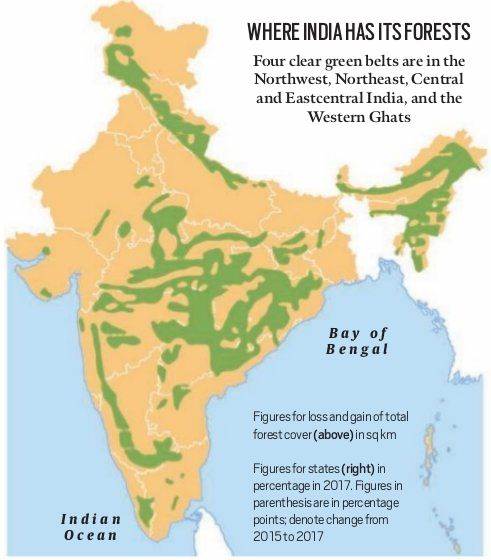India’s forest cover loss in 17 years is four times the size of Goa
India has lost over 1.6 million hectare of tree cover between 2001 and 2018, about four times the geographical area of Goa, according to a new study released by the World Resources Institute (WRI), a global research non-profit, on Thursday.
In India, five north-eastern states — Nagaland, Tripura, Meghalaya, Mizoram and Manipur — were responsible for over 50% of all tree cover loss in the same period, data analysed by WRI’s Global Forest Watch shows. The loss of tree cover contributed to 172 MT of carbon emissions in India during this period, according to the study.

The analysis reveals the total tree cover which used to be 12% of the country’s geographical area in 2000 reduced to 8.9% in 2010. The Global Forest Watch uses a dataset collated by the University of Maryland, Google, US Geological Survey, and the National Aeronautics and Space Administration (NASA), besides satellite images, to map tree cover (at 30 metre resolution) globally for the years 2000 and 2010. The dataset defines all vegetation taller than 5 metres in height to be tree cover.
“The data used by Global Forest Watch for this analysis is very coarse for India. The dataset also doesn’t cover open forest and scrub forest which is a big composition of forests in India. The main reason for loss of tree cover in the north-eastern states is diversion of forest land; climate change is also impacting the quality of forests,” said Ruchika Singh, director, sustainable landscapes and restoration at WRI India. The data analysis shows that “forestry” or large-scale plantations, are paradoxically, the main drivers for tree cover loss in India.
But Global Forest Watch’s findings are vastly different from that of the Forest Survey of India which has been recording a gradual increase in tree and forest cover during the same period. According to FSI’s 2005 and 2017 “State of the Forest Reports”, the tree cover increased to 93,815 sq km from 91,663 sq km in this 12-year period. “Global Forest Watch has a very coarse resolution. It was started for monitoring deforestation in Brazil. But there is a recent report by NASA which says China and India responsible for greening of the globe. It is far more scientific than the Global Forest Watch. Our data shows gradual rise in forest and tree cover and forest carbon storage,” said Subhash Asutosh, director general, FSI.
Explaining the Indian method of collecting data, Saibal Dasgupta, a former director general of FSI, said, “In the last two years forest and tree cover has increased by 1% in India. We do wall-to-wall mapping. One reason why there could be a discrepancy with Global Forest Watch’s findings is that we cover any tree with even 2 metres height in our tree and forest cover analysis. We cover pretty much all vegetation visible through satellite data.” Professor NH Ravindranath, forestry expert at the Indian Institute of Science, also pointed out how Indian definition of tree cover is different from others.
Originally published by Hindustan Times




